Phylum Chordata Scientific name Elephas maximus maximus Rank Subspecies | ||
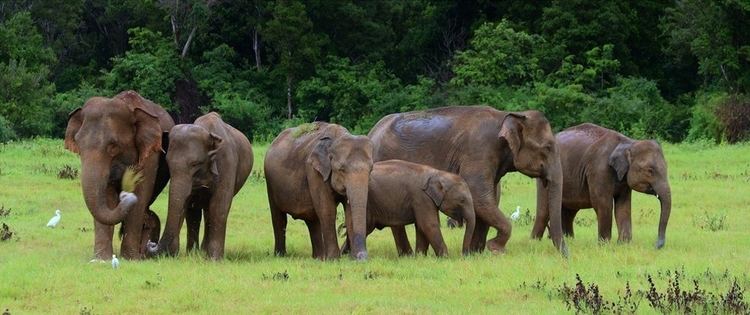 | ||
Similar Asian elephant, Elephas, Sri Lankan leopard, Mammal, Sumatran elephant | ||
The Sri Lankan elephant (Elephas maximus maximus) is one of three recognized subspecies of the Asian elephant, and native to Sri Lanka. Since 1986, Elephas maximus has been listed as endangered by IUCN as the population has declined by at least 50% over the last three generations, estimated to be 60–75 years. The species is pre-eminently threatened by habitat loss, degradation and fragmentation.
Contents
- Characteristics
- Distribution and habitat
- Former range
- Population trend
- Ecology and behaviour
- Threats
- Conservation
- Cultural depiction
- References

Elephas maximus maximus is the type subspecies of the Asian elephant, first described by Carl Linnaeus under the binominal Elephas maximus in 1758.
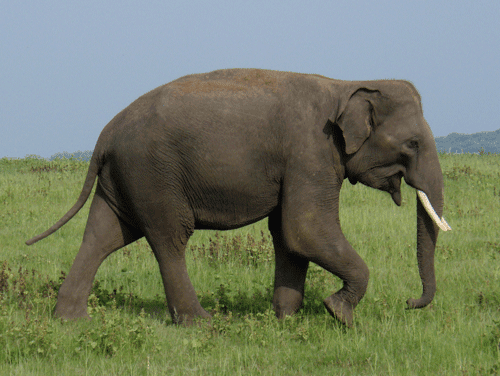
The Sri Lankan elephant population is now largely restricted to the dry zone in the north, east and southeast of Sri Lanka. Elephants are present in Udawalawe National Park, Yala National Park, Lunugamvehera National Park, Wilpattu National Park and Minneriya National Park but also live outside protected areas. It is estimated that Sri Lanka has the highest density of elephants in Asia. Human-elephant conflict is increasing due to conversion of elephant habitat to settlements and permanent cultivation.
Characteristics

In general, Asian elephants are smaller than African elephants and have the highest body point on the head. The tip of their trunk has one finger-like process. Their back is convex or level. Females are usually smaller than males, and have short or no tusks.
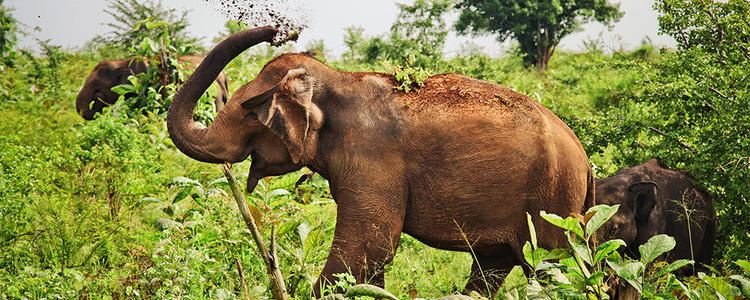
Sri Lankan elephants are the largest subspecies reaching a shoulder height of between 2 and 3.5 m (6.6 and 11.5 ft), weigh between 2,000 and 5,500 kg (4,400 and 12,100 lb), and have 19 pairs of ribs. Their skin color is darker than of indicus and of sumatranus with larger and more distinct patches of depigmentation on ears, face, trunk and belly.
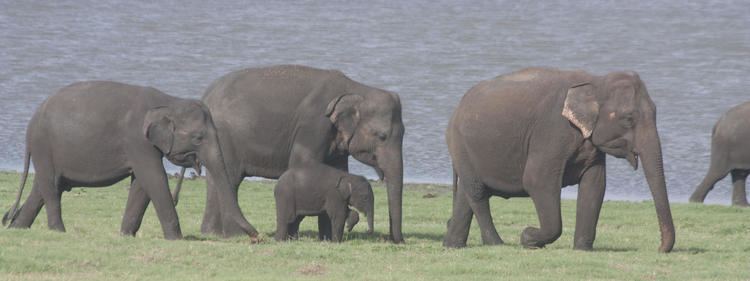
Only 7% of males bear tusks. According to the elephant census conducted in 2011 by the Wildlife Conservation Department of Sri Lanka, only 2% of the total population are tuskers.
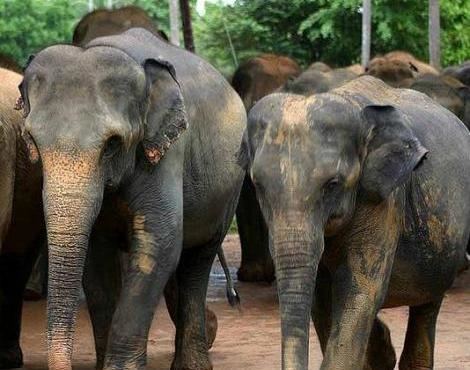
Sri Lankan elephants are somewhat diminutive when compared with historical accounts dating back to 200 BC and with photographs taken in the 19th century during the time of colonial British rule of the island. The smaller size could possibly be the end result of a long-continued process of removing the physically best specimens from the potential breeding-stock through hunting or domestication (see insular dwarfism).
Distribution and habitat
Sri Lankan elephants are restricted mostly to the lowlands in the dry zone where they are still fairly widespread in north, south, east, north-western, north-central and south-eastern Sri Lanka. A small remnant population exists in the Peak Wilderness Sanctuary. They are absent from the wet zone of the country. Apart from Wilpattu and Ruhuna National Parks, all other protected areas are less than 1,000 km2 (390 sq mi) in extent. Many areas are less than 50 km2 (19 sq mi), and hence not large enough to encompass the entire home ranges of elephants that use them. In the Mahaweli Development Area, protected areas such as Wasgomuwa National Park, Flood Plains National Park, Somawathiya National Park, and Trikonamadu Nature Reserve have been linked resulting in an overall area of 1,172 km2 (453 sq mi) of contiguous habitat for elephants. Nevertheless, about 65% of the elephants range extends outside protected areas.
Former range
In the historical past, elephants were widely distributed from sea level to the highest mountain ranges. They occurred in the dry zone, in the lowland wet zone as well as in the cold damp montane forests. During the colonial period from 1505 to 1948, the wet zone was converted to commercially used fields and became heavily settled. Until 1830, elephants were so plentiful that their destruction was encouraged by the government, and rewards were paid for any that was killed. In the first half of the 19th century, forests in the montane zone were cleared large-scale for the planting of coffee, and afterwards tea. The elephant population in the mountains was extirpated. During the British rule, many bull elephants were killed by trophy hunters. One of the army majors is credited with having shot over 1,500 elephants, and two others are reputed to have shot half that number each. Many other sportsmen have shot about 250-300 animals during this time. Between 1829 and 1855 alone, more than 6,000 elephants were captured and shot.
By the turn of the 20th century, elephants were still distributed over much of the island. The area currently known as Ruhuna National Park was the Resident Sportsmen's Shooting Reserve, an area reserved for the sporting pleasure of British residents in the country. In the early 20th century, mega reservoirs were constructed in the dry zone for irrigated agriculture. Ancient irrigation systems were rehabilitated and people resettled. This development gathered momentum after the independence in 1948. As a result, elephant habitat in the dry zone was severely fragmented.
Population trend
The size of wild elephant populations in Sri Lanka was estimated at
Ecology and behaviour
Elephants are classified as megaherbivores and consume up to 150 kg (330 lb) of plant matter per day. As generalists they feed on a wide variety of food plants. In Sri Lanka's northwestern region, feeding behaviour of elephants was observed during the period of January 1998 to December 1999. The elephants fed on a total of 116 plant species belonging to 35 families including 27 species of cultivated plants. More than half of the plants were non tree species, i.e. shrub, herb, grass, or climbers. More than 25% of the plant species belonged to the family Leguminosae, and 19% of the plant species belonged to the family of true grasses. The presence of cultivated plants in dung does not result solely due to raiding of crops as it was observed that elephants feed on leftover crop plants in fallow chenas. Juvenile elephants tend to feed predominantly on grass species.
Food resources are abundant in regenerating forests, but at low density in mature forests. Traditional slash-and-burn agriculture creates optimum habitat for elephants through promoting successional vegetation.
Threats
During the armed conflict in Sri Lanka, elephants were maimed or killed by land mines. Between 1990 and 1994, a total of 261 wild elephants died either as a result of gunshot injuries, or were killed by poachers and land mines. Several elephants stepped on land mines and were crippled.
Today, given the rarity of tuskers in Sri Lanka, poaching for ivory is not a major threat. Nevertheless, some trade in ivory still goes on. Kandy has been identified as the centre for such illegal trade. The greatest threat to elephants comes from an expanding human population and its demand for land. Loss of significant extents of elephant range to development continues currently, with a number of irrigation and development projects leading to the conversion of more elephant ranges to irrigated agriculture and settlements.
Between 1999 to the end of 2006 every year nearly 100 wild elephants were killed. Elephants are killed to protect crops and houses. Other threats are poaching, deforestation, drought and starvation. During drought seasons many elephants damage agricultural land for food. Nearly 80 elephants were killed in north western Sri Lanka, 50 in south and east, and another 30 in other parts of the country, totaling 160 elephant deaths in 2006 alone.
Conservation
Elephas maximus is listed on CITES Appendix I.
The elephant conservation strategy of the Department of Wildlife Conservation aims at conserving as many viable populations as possible in as wide a range of suitable habitats as is feasible. This means protecting elephants both within the system of protected areas and as many animals outside these areas that the land can support and landholders will accept, and not restricting elephants to the protected area network alone.
Cultural depiction
Elephants were a common element in Sinhalese heraldry for over two thousand years and remained so through British colonial rule. The coat of arms and the flag of Ceylon Government from 1875 to 1948 included an elephant and even today many institutions use the Sri Lankan elephant in their coat of arms and insignia.
An important cultural symbiosis has continued to exist between the elephant and humans for over two thousand years – no religious procession was complete without its retinue of elephants, and many large Buddhist temples in Sri Lanka had their own elephants.
